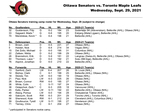Мудаки
26-09-2021 15:28
к комментариям - к полной версии
- понравилось!
вверх^
к полной версии
понравилось!
в evernote
Текст скрыт для удобства комментирования
PSG starting XI: Donnarumma, Hakimi, Marquinhos, Kimpembe, Nuno Mendes, Verratti, Herrera, Gueye, Neymar, Messi, Mbappe
Man City starting XI: Ederson, Walker, Dias, Laporte, Cancelo, Rodri, Mahrez, De Bruyne, Bernardo Silva, Grealish, Sterling
#UCL
Израиль_Гальперин
28-09-2021-21:09
удалить
Аякс фачит Бешикташ 2-0, Интер с Шахтой катают унылое нулевое говно.
Blind_Deaf
28-09-2021-21:14
удалить
Ответ на комментарий Таки_Абрам #

Исходное сообщение Таки_Абрам Исходное сообщение Older_Laszlo Николай Арутюнов, основатель "Лиги Блюза" - всё... Помянем, 63 года. Эх ...довольно неожиданно.... Уходят лучшие из наших....
Таки_Абрам
28-09-2021-21:44
удалить
Ещё и басист из Статус Кво вчера помер
With the Southern Sauvignon Blanc Encounter between South Africa and New Zealand poised on a knife-edge, South Africa put in a superb showing in the final rounds, winning this unique competition with an average score of 90.4/100pts to the Kiwis’ 89.4/100. It was New Zealand, however, who produced the top-scoring wines of the day with its Villa Maria Reserve Sauvignon Blanc 2020 and Astrolabe Sauvignon Blanc 2020 topping the score-sheets with ratings of 93.4/100 and 93/100 respectively. South African winery Stark-Conde from Stellenbosch put in the best showing by a Cape wine with a commendable 92.8/100.
For this Southern Sauvignon Blanc Encounter between the two Southern Hemisphere sporting rivals, 10 wines from New Zealand squared up to 10 from South Africa, both sets of wines specially selected for this competition by panels of experts from each respective country. The contest, organized by New Zealand wine producer Erica Crawford and Cape-based independent wine marketer Emile Joubert, was arranged as a part of the celebrations honouring 100 years of rugby rivalry between South Africa and the Land of the Long White Cloud. Crawford worked with Cameron Douglas MW to select a line-up of 10 Sauvignon Blanc wines from her homeland, and all the wines were from the world-famous Marlborough region on the South Island. Joubert collaborated with Sauvignon Blanc SA, the marketing arm for Cape Sauvignon Blanc, who assisted him in picking a 10-wine line-up.
Таки_Абрам
28-09-2021-21:53
удалить
А сегодня кстати день особый
30 лет как великий Майлс Дэвис ласты завернул
Miles Davis - Tutu :
Маркус Миллер в клипе не лысый ещё, с причёской, охтыж мля
Маркус Миллер в клипе не лысый ещё, с причёской, охтыж мля
Израиль_Гальперин
28-09-2021-21:58
удалить
Столько народу умирает, пздц. Скоро одни бузовы остануццо.
Ну а як зіграли ваші ставки?
 [680x519]
[680x519]
 [680x519]
[680x519]
досонячне зерно...
 [323x700]
[323x700]
 [323x700]
[323x700]
The first goal goes to PSG scored by who else but Idrissa Gana Gueye.
The #Sens have announced a 23-man roster for Wednesday's preseason game at
@CdnTireCtr
against Toronto
 [700x523]
[700x523]
 [700x523]
[700x523]
Таки_Абрам
28-09-2021-22:29
удалить
Отета Мансюки отожгли
Два раза в перекладину и ещё в штангу в одной атаке
А гола нет
Таки_Абрам
28-09-2021-22:31
удалить
Молдоване повели в Мадриде, аххахах
Израиль_Гальперин
28-09-2021-22:41
удалить
Да, Яхшибоев забил. Видел его в чемпе Беларуси.
https://twitter.com/i/status/1442935836081725447
Они полтора года реконструировали стадио чтобы... натянуть эту тряпку?
🔵⚫️ Hans Vanaken has now scored his last 4 games in the Champions League for Club Brugge🔥
 [360x240]
[360x240]
 [360x240]
[360x240]
Забили два центрхавчика-бельгийца - Ванакен и Ритс.
Походу-то и фламандцы обадва.
Израиль_Гальперин
28-09-2021-23:28
удалить
Грилиш дурачок какой-то, нахрена за него столько отсыпали?
Израиль_Гальперин
28-09-2021-23:34
удалить
Первая банка гномео
Covering the southern portion of the country, Wallonia is primarily French-speaking, and accounts for 55% of Belgium's territory, but only a third of its population. The Walloon Region was not merged with the French Community of Belgium, which is the political entity responsible for matters related mainly to culture and education, because the French Community of Belgium encompasses both Wallonia and the bilingual Brussels-Capital Region.
There is a German-speaking minority in eastern Wallonia, resulting from the annexation of three cantons previously part of the German Empire at the conclusion of World War I. This community represents less than 1%[5] of the Belgian population. It forms the German-speaking Community of Belgium, which has its own government and parliament for culture-related issues.
During the industrial revolution, Wallonia was second only to the United Kingdom in industrialization, capitalizing on its extensive deposits of coal and iron. This brought the region wealth, and from the beginning of the 19th to the middle of the 20th century, Wallonia was the more prosperous half of Belgium. Since World War II, the importance of heavy industry has greatly diminished, and the Flemish Region has exceeded Wallonia in wealth as Wallonia has declined economically. Wallonia now suffers from high unemployment and has a significantly lower GDP per capita than Flanders. The economic inequalities and linguistic divide between the two are major sources of political conflicts in Belgium and a major factor in Flemish separatism.
The capital of Wallonia is Namur, and the most populous city is Liège. Most of Wallonia's major cities and two-thirds of its population lie along the east–west aligned Sambre and Meuse valley, the former industrial backbone of Belgium. To the north of this valley, Wallonia lies on the Central Belgian Plateau, which, like Flanders, is a relatively flat and agriculturally fertile area. The south and southeast of Wallonia is made up of the Ardennes, an expanse of forested highland that is less densely populated.
Израиль_Гальперин
28-09-2021-23:41
удалить
Дубль Фирмино, Ливер 5-1
Вы сейчас не можете прокомментировать это сообщение.
Дневник Мудаки | ДЕНЖЕР-ЗОНА - Cообщество ДЕНЖЕР-ЗОНА |
Лента друзей ДЕНЖЕР-ЗОНА
/ Полная версия
Добавить в друзья
Страницы:
«позже
раньше»
